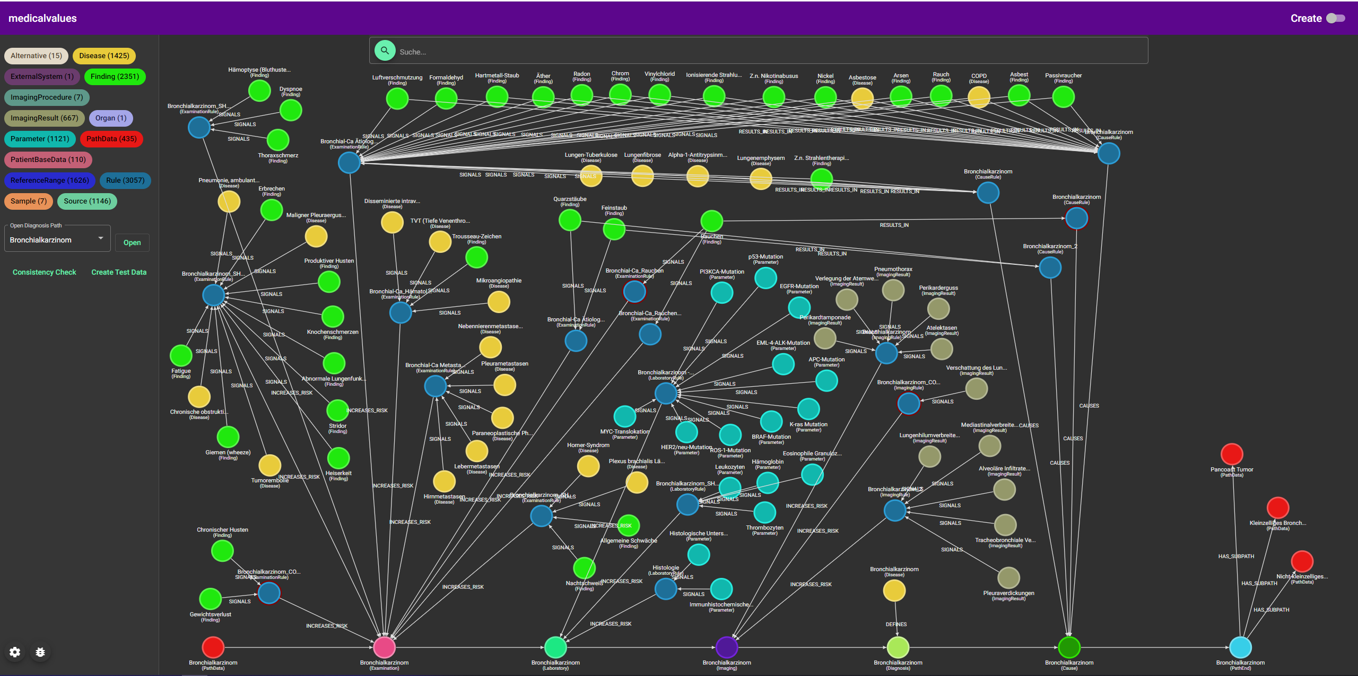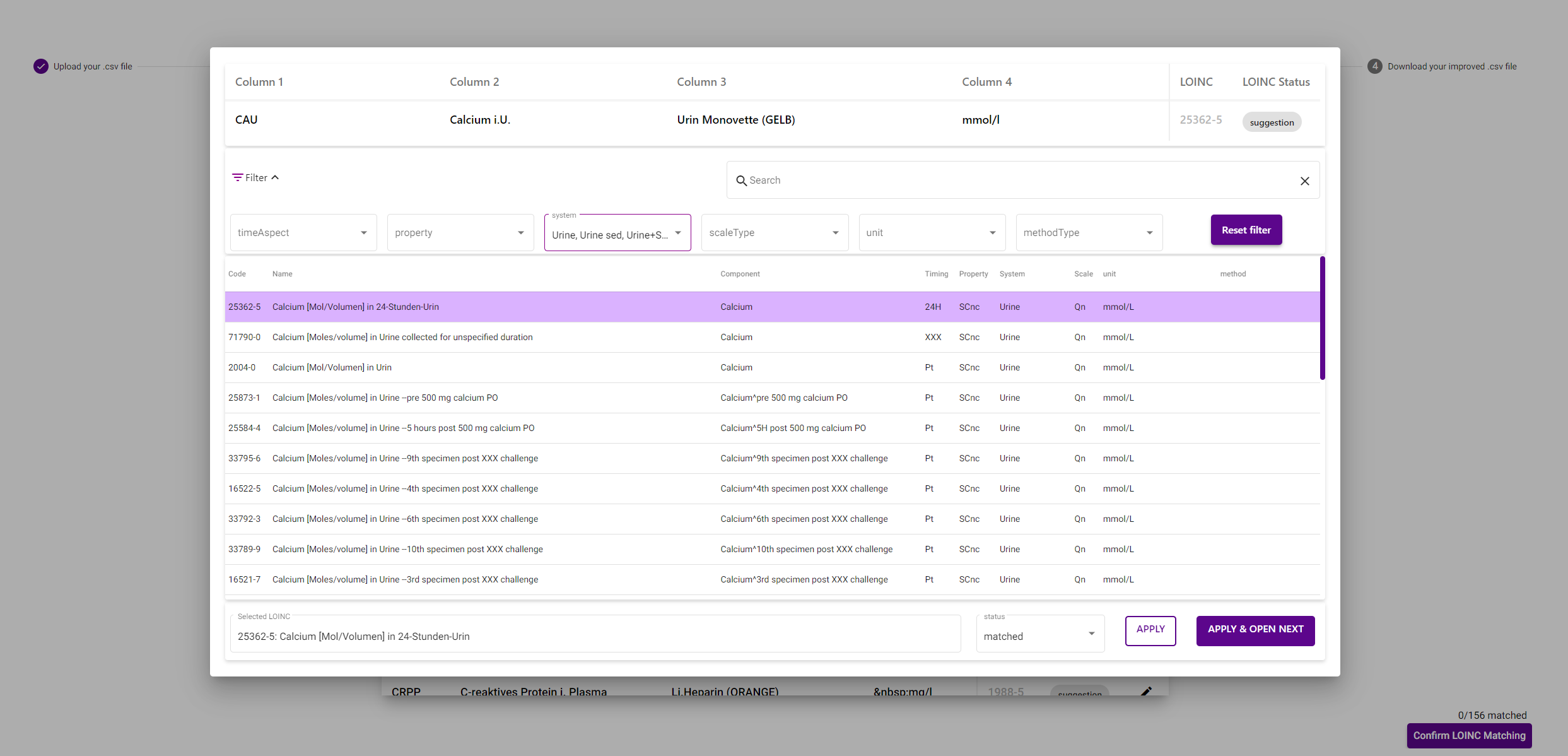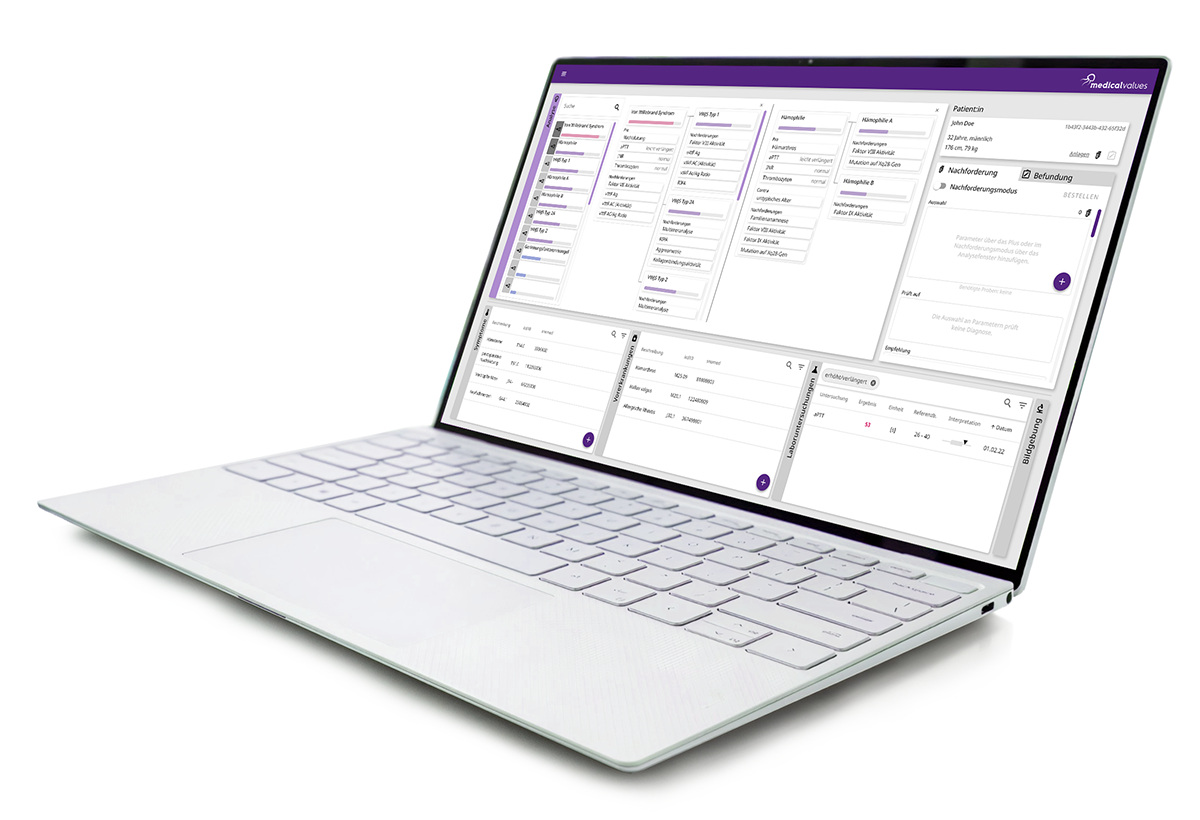Company profile: medicalvalues GmbH
medicalvalues – best possible diagnostics thanks to AI
The Karlsruhe-based start-up medicalvalues GmbH wants to use its platform to bring together different clinical data sets and thus enable comprehensive medical diagnostics. Artificial intelligence featuring innovative diagnostic algorithms is used to evaluate the data and generate new insights for laboratories and hospitals.
Nowadays, there are many medical diagnostics methods. For example, patients' blood can be analysed for various parameters, while imaging procedures provide incredible glimpses into the human body. However, the complexity increases with the amount of information obtained. Doctors struggle to interprete the data, especially in the short time that is often available.
AI use in clinical routine
 Diagnostic pathway for the indication bronchial carcinoma: the graph represents medical knowledge based on current guidelines and evidence-based medicine. The diagnostic process is thus modelled for each individual clinical picture. © medicalvalues GmbH
Diagnostic pathway for the indication bronchial carcinoma: the graph represents medical knowledge based on current guidelines and evidence-based medicine. The diagnostic process is thus modelled for each individual clinical picture. © medicalvalues GmbHA new artificial intelligence (AI) application could remedy the situation: the Karlsruhe-based start-up medicalvalues GmbH has created a decision support system that offers a completely new way for artificial intelligence to support doctors and laboratories in their work. "Diagnostics is highly complex, so it is not always possible for those treating patients to do full justice to all the theoretically available diagnostic information within the available treatment time. Many medical laboratory parameters are interdependent and often difficult to evaluate in isolation," explains Carmen Diker, Go-to-Market Manager at medicalvalues. "We want to enable the best possible diagnostics tailored to a patient’s individual requirements." To achieve this, the company founders use machine learning to combine numerous medical disciplines and research knowledge in a knowledge graph (knowledge database).
"We use white-box AI because it is important for us to make AI decisions comprehensible," says Jan Kirchhoff, managing director of the company, explaining the application in concrete terms. In contrast to black-box AI, white-box AI makes it possible for the user to understand how the software arrives at certain results on the basis of the data used. Another name for it is explainable AI. "In exploratory mode, we also rely on ‘classic’ black-box machine learning methods – however, for use in clinical routine it is important to ensure appropriate versioning of the algorithms. Or to put it shortly, exploratory mode works always, while predictions must be validated for use in clinical settings," says Kirchhoff.
Info box:
Black-box AI: Uses machine learning models that are based on purely statistical methods. This means that the user is only able to understand the predictions to a limited extent.
White-box AI: Uses machine learning models that employ analytical and physical descriptions. They enable the user to better understand how they produce predictions and what the influencing variables are.
Grey-box AI: Both approaches are combined.
Merging data sets
 The Diagnostic Data Mapper enables semi-automated standardisation of laboratory data according to the international LOINC standard. © medicalvalues GmbH
The Diagnostic Data Mapper enables semi-automated standardisation of laboratory data according to the international LOINC standard. © medicalvalues GmbHLaboratory data, symptoms, demographic data, radiology and pathology data can be combined on the medicalvalues platform. The data is evaluated with the help of machine learning using clinical experience, research data and medical guidelines. Hospitals can thus, for example, receive diagnostic support that combines data from different disciplines (data mapping). "The merging of data is possible thanks to the harmonisation and standardisation of information through international standards such as SNOMED CT, LOINC and FHIR," explains Diker. LOINC stands for ‘Logical Observation Identifier Names and Codes’ and is an international standard for medical observations and measurements. "We are aware that we have to take customers by the hand and introduce them to the platform, because there are still many incoherence between the systems and many standards are still being established. This is where we provide support with our Diagnostic Data Mapper, for example," explains Kirchhoff, a business data scientist who founded the company together with Florian Stumpe. "For us, being able to add value for practical appication is key. Therefore, it is important to proceed in a pragmatic, iterative and sustainable way."
In addition to technical and semantic integration, the goal is also the effective integration of the platform into already existing systems in hospitals and laboratories, to avoid creating yet another interface for users. Some of the start-up’s applications are currently in the process of being approved as medical products.
Challenges and hurdles
As if standardising the data wasn't enough of a challenge, the company founders also have to contend with data protection concerns. However, the solution is designed to be operated as a SaaS (software-as-a-service) cloud application or installed as a managed service for operation on the clients' local servers to ensure that no patient data leaves the hospital or laboratory. "Data protection is an important issue. We are basically in favour of strict rules regarding the use of data, but a uniform nationwide strategy would be desirable to avoid further silo solutions," says Kirchhoff.
 This is what the user interface for doctors for reporting and requesting tests could look like. © medicalvalues GmbH
This is what the user interface for doctors for reporting and requesting tests could look like. © medicalvalues GmbHThe founders have been able to attract business angels and investors from the industry to finance their idea, and the team of medical professionals and IT experts is growing steadily. Pilot customers from Germany and abroad have also been acquired, including leading laboratory chains. The next goals are to expand the medical algorithms to cover an even broader spectrum of diseases. This will primarily involve making optimal use of already existing data to enable the best possible diagnostics for all. In future, however, ‘omics’ data sets will also find their way into the system, which will include genetic analyses (genomics) and the study of proteins (proteomics). medicalvalues has entered into partnerships with various software providers in order to make it easier for users to integrate the platform into their existing systems. This partner ecosystem will be further expanded in the future.
Other possible uses of the platform are in cross-sectoral care and telemedicine. "We also have a particular interest in entering into strategic partnerships with hospitals. Within the framework of the Hospital Future Act in Germany, decision support systems are eligible for funding, so now we have to roll up our sleeves and establish sustainable structures," he says.